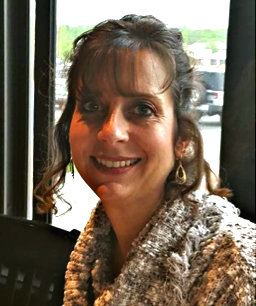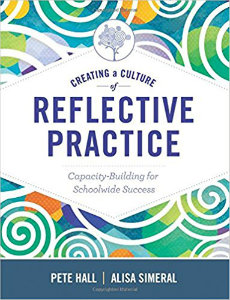Building Communities of Reflective Practice
Creating a Culture of Reflective Practice: Capacity-Building for Schoolwide Success
By Pete Hall and Alisa Simeral
(ASCD, 2017 – Learn more)

Touchdown!
Keeping in line with the sports metaphors used throughout this book, I believe Creating a Culture of Reflective Practice IS a winner and well worth reading.
Hall and Simeral write using an entertaining yet professional voice to share their findings after implementing a process of self-reflection and collaboration across an entire school that positively impacted instruction and resulted in higher student learning.
Take a look at the Anderson School turnaround story in Educational Leadership titled A School Reclaims Itself. Hall explains how he supported a school from “being the lowest-achieving school in Nevada… to the only Title 1 school in the state to earn a High Achieving designation just two years later.”

This new book addresses the growth of reflective practice among all stakeholders in a school who are responsible for student achievement – not just teachers – and provides detailed strategies and resources to help others do so.
My excitement grew as I turned every page because I knew the winners of this game were all teams playing. Yes! This is exactly what all our schools need! The strategies offered in this book align directly with the type of thinking expected of National Board Certified Teachers, which I am also trying to address in my own school. Best of all, the authors break down a monumental and hard to explain task into manageable and easy to understand pieces. Let the game begin!
Part 1: The Game
In this section, the authors tackle us with the reality that schools are not doing enough. Please don’t roll your eyes thinking, “I already do enough. How much more can I do?” It’s not about teachers doing more but about building the capacity to self-reflect that leads to improved student achievement. “We can, and we must, reach every single child, every single moment: 100 percent.” As the old saying goes, The Buck Stops Here. Our quality of instruction is key to student success.
We then learn the rationale for self-reflection along with the key concepts and fundamentals that make up a reflective practice. At this point, we are provided brief descriptions of the four stages of self-reflection: Unaware, Conscious, Action, and Refinement. In addition, a chart and explanation are included with a possible timeline for implementation and making it to the finish line.
Part 2: The Players and the Playing Field
The authors delve into the first four of the seven fundamentals. For each, there is an explanation of theory, in-depth description of how to implement, guiding questions to provoke the thinking of capacity-builders, scenarios which bring the fundamentals to life, and a wrap-up.
- Relationships, Roles, and Responsibilities
- Expectations and Communication
- Celebration and Calibration
- Goal Setting and Follow-Through
This section is more about the nuts and bolts for administrators to reflect upon and initiate with their staff. Hall and Simeral remind us, for each of the fundamentals, to make this process our own. “(K)eep in mind the spirit and big ideas of this fundamental—minding the related Theory of Action at all times!—and to think very critically about your collective rationale for making any changes before doing so.”
Part 3: The Playbook
Here we learn how all the pieces come together to assure “significant reflective growth, powerful instructional development, and increased student learning.” The final three fundamentals are presented with clear explanations and prompts for the capacity-builders to use with teachers in the different stages on the Continuum of Self-Reflection to put this all into play.
- Strategic PLC and Teacher-Leadership Support
- Transformational Feedback
- Differentiated Coaching
Finally, there is a comprehensive view of each of the four stages of self-reflection which includes a description, identification of the stage in teaching, the reflective tendencies of teachers in the specific stage, supportive practices, strategic PLC and support, differentiated coaching strategies, and detailed scenarios of support in action.
View From the Stands
I have to admit my brain is on overload after reading this well-written and designed book, but my excitement about implementing this in a school has not diminished. While I feel overwhelmed at the moment, the text clearly lays out everything in a way that allows capacity builders to use it more like a handbook or playbook for building a culture of reflective practitioners.
Although I am not currently in an administrative position, I reaped a considerable amount of information that left me with many I wonders, questions, and ideas on how to improve my personal practice, which will impact students as well as other educators.
Now, it’s time for me to reflect upon the text and then decide on a goal and plan of action to ensure a winning game!
Lorie Shiveley, a 29-year education veteran, has served as an elementary teacher, Language Arts Specialist, and adjunct professor, and currently serves as a middle school language arts teacher. Shiveley is an officer of the Indiana National Board of Certified Teachers Network. She presents Explore National Board, co-facilitates Jump Start, and is a Professional Learning Facilitator for National Board candidates. Shiveley is a National Board Certified Teacher in Early Adolescence English/ Language Arts.


































